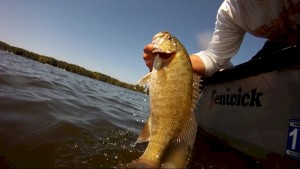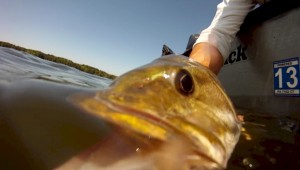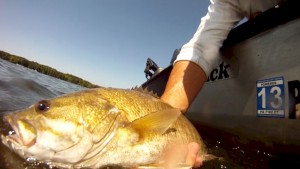 It’s been a unusual summer where lakes that have been traditionally good, in Western Pennsylvania, are not fishing all that well. The up-side to this is that it forces anglers to adapt and find new waters or techniques to capitalize on. With the nights cooling off now, in the end of August and early September, baitfish have began to ball up giving the gamefish prey to focus on. To my surprise, two recent trips to catch Largemouth Bass have turned into great Smallmouth Bass days… days that would traditionally not be prime for smallies (high blue bird skys).
It’s been a unusual summer where lakes that have been traditionally good, in Western Pennsylvania, are not fishing all that well. The up-side to this is that it forces anglers to adapt and find new waters or techniques to capitalize on. With the nights cooling off now, in the end of August and early September, baitfish have began to ball up giving the gamefish prey to focus on. To my surprise, two recent trips to catch Largemouth Bass have turned into great Smallmouth Bass days… days that would traditionally not be prime for smallies (high blue bird skys).
When Bass are feeding on bait balls, I look to fish the wind or areas that the wind is affecting the movement of prey. The wind blows the bugs and organisms in a direction to which the bait will follow to feed on. This bait movement is followed by the gamefish! Points, Islands, shallow drop offs, shoreline cover all create areas where current flow is broken. This  break in the flow creates eddies, slack pools, and other type anomalies for bass to stage on where they can feed up. Combine these factors with a hard bottom and you may find wolf packs of Smallmouth Bass (or Largemouth) congragating when the nights start to cool off. They will instinctively seek these area to feed when the surface temperature starts to drop. When fishing these areas you will realize that even if you are way out in the lake, you may acutally be fishing a long point or secondary point. With this, even the smallest depth change can be enough to hold large groups of bass waiting for an easy meal.
break in the flow creates eddies, slack pools, and other type anomalies for bass to stage on where they can feed up. Combine these factors with a hard bottom and you may find wolf packs of Smallmouth Bass (or Largemouth) congragating when the nights start to cool off. They will instinctively seek these area to feed when the surface temperature starts to drop. When fishing these areas you will realize that even if you are way out in the lake, you may acutally be fishing a long point or secondary point. With this, even the smallest depth change can be enough to hold large groups of bass waiting for an easy meal.
On two of my recent trips, I started out looking for the areas, which I just spoke of, starting out with search baits (crankbaits, top waters, spinnerbaits, etc). Once located, I realized there was no need to change my presentation  because active feeding bass will look for a aggressive moving target. Crankbaits can be determined on the depth which you are fishing but I would always recommend matching the size of the bait which the bass are feeding on. If you can’t see the bait, take notice to what the bass is spitting up as you are catching them. Another good tip is to put a few in the livewell (releasing them later) to see what they cough up. The days that I spent catching over 60 smallmouth in a few hours provided clues with the water looking like a chum slick from all the bait that was spit out from the bass feast! This time of year, you need to find the hard
because active feeding bass will look for a aggressive moving target. Crankbaits can be determined on the depth which you are fishing but I would always recommend matching the size of the bait which the bass are feeding on. If you can’t see the bait, take notice to what the bass is spitting up as you are catching them. Another good tip is to put a few in the livewell (releasing them later) to see what they cough up. The days that I spent catching over 60 smallmouth in a few hours provided clues with the water looking like a chum slick from all the bait that was spit out from the bass feast! This time of year, you need to find the hard  bottom, determine the wind direction, locate the best areas of the structure, make a presentation that is either natural or able to entice a reaction strike. Look for points and drops and determine the depth. Watch the birds!… the birds will tell you allot… One lone seagull on the back side of a point or island can provide a good starting point. www.skinard.com
bottom, determine the wind direction, locate the best areas of the structure, make a presentation that is either natural or able to entice a reaction strike. Look for points and drops and determine the depth. Watch the birds!… the birds will tell you allot… One lone seagull on the back side of a point or island can provide a good starting point. www.skinard.com